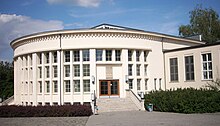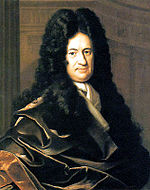Leipzig University
Universität Leipzig | |
 | |
| Latin: Alma mater Lipsiensis | |
| Motto | Aus Tradition Grenzen überschreiten - Crossing Boundaries out of Tradition |
|---|---|
| Type | Public |
| Established | December 2, 1409 |
| President | Beate Schücking |
| Students | 28,125 (winter 2011/12)[1] |
| Location | , , |
| Campus | Urban |
| Website | www.uni-leipzig.de |
| Leipzig University Logo.jpg | |

Leipzig University (German: Universität Leipzig), located in Leipzig in the Free State of Saxony, Germany, is one of the oldest universities in the world and the second-oldest university (by consecutive years of existence) in Germany. Famous alumni include Leibniz, Goethe, Ranke, Nietzsche, Wagner, Angela Merkel, Raila Odinga, Tycho Brahe[citation needed] and nine Nobel laureates are associated with this university.
The university was founded on December 2, 1409 by Frederick I, Elector of Saxony and his brother William II, Margrave of Meissen, and originally comprised the four scholastic faculties. Since its inception the university has engaged in teaching and research for over 600 years without interruption.
History
This section needs additional citations for verification. (December 2011) |
Founding and development until 1900

The university was modelled on the University of Prague, from which the German-speaking faculty members withdrew to Leipzig after the Jan Hus crisis and the Decree of Kutná Hora. The Alma mater Lipsiensis opened in 1409, after it had been officially endorsed by Pope Alexander V in his Bull of Acknowledgment on (September 9 of that year). Its first rector was Johann von Münsterberg. From its foundation, the Paulinerkirche served as the university church. After the Reformation the church and the monastery buildings were donated to the university in 1544.
As many European universities, the university of Leipzig was structured into colleges (Collegia) which were responsible for organising accommodation and collegiate lecturing. Among the colleges of Leipzig were the Small College, the Large College, the Red College (also known as the New College), the College of our Lady and the Pauliner-College. There were also private residential halls (Bursen, see engl. bursaries). The colleges had jurisdiction over their members. The college structure was abandoned later and today only the names survived.
During the first centuries the university grew slowly and was a rather regional institution. This changed, however, during the 19th century when the university became a world-class institution of higher education and research.[citation needed]
Leipzig University was one of the first German universities to allow women to register as "guest students".[2] At its general assembly in 1873 the Allgemeiner Deutscher Frauenverein thanked the University of Leipzig and Prague for allowing women to attend as guest students. This was the year that the first woman in Germany obtained her JD, Johanna von Evreinov.
Until the beginning of the Second World War, Leipzig University attracted a number of renowned scholars and later Nobel Prize laureates. Many of the university's alumni became important scientists.
Nazi period
Under Nazi rule many Jews' degrees were cancelled;[3] some were later reinstated as Karl-Marx University degrees by the GDR.
The university was kept open throughout World War II, even after the destruction of its buildings. During the war the acting rector, Erich Maschke, described the continuation of the university in a memo on May 11, 1945, announcing the vote for a new rector:
Since 4 December 1943 a fixed determination not to abandon the Leipzig University in the most difficult hour of its more than five-hundred-year history has bonded the professors with each other and with the students. The special task of repairing the damage caused by air attacks has now broadened out to the more general duty to save the continuity of our university and preserve its substance, at the very least its indestructible kernel, through the crisis that has now reached its fullest stage. After the destruction of most of the buildings and the majority of its libraries, this kernel is represented by the professoriate alone. This is what must be preserved as the great repository of value in the university.[4]
By the end of the war 60 per cent of the university's buildings and 70 per cent of its books had been destroyed.
The University under the German Democratic Republic
The university reopened after the war on February 5, 1946, but it was affected by the uniformity imposed on social institutions in the Soviet occupation zone. In 1948 the freely elected student council was disbanded and replaced by Free German Youth members. The chairman of the Student Council, Wolfgang Natonek, and other members were arrested and imprisoned, but the university was also a nucleus of resistance. Thus began the Belter group, with flyers for free elections. The head of the group, Herbert Belter, was executed in 1951 in Moscow. The German Democratic Republic was created in 1949, and in 1953 the University was renamed by its government the Karl-Marx-University, Leipzig. In 1968, the partly damaged Augusteum, including Johanneum and Albertinum and the intact Paulinerkirche, were demolished to make way for a redevelopment of the university, carried out between 1973 and 1978. The dominant building of the university was the University Tower (now City-Hochhaus Leipzig), built between 1968 and 1972 in the form of an open book.
After the reunification of Germany
In 1991, following the reunification of Germany, the University's name was restored to the original Leipzig University (Alma mater lipsiensis). The reconstruction of the University Library, which was heavily damaged during the war and in the GDR barely secured, was completed in 2002. In 2008 the university was able to prevail in the nationwide "Initiative of Excellence" of Germany and it was granted the graduate school "BuildMoNa: Leipzig School of Natural Sciences – Building with Molecules and Nano-objects".[5] In addition the university was able to receive grants from the Saxon excellence initiative for the "Life" project – a project that tries to explore common diseases more effectively. Also in 2008 the "Bach Archive" was associated with the university. With the delivery of the University Tower to a private user, the university was forced to spread some faculties over several locations in the city. It controversially redesigned its historical centre at the Augustusplatz. In 2002 Behet Bonzio received the second prize in the architectural competition; a first prize was not awarded by the jury. A lobby with partial support of the provincial government called for the rebuilding of St. Paul's Church and Augusteum. This caused the resistance of the university leadership, the majority of the students and population of Leipzig. These disputes led to a scandal in early 2003; the Rector Volker Bigl, and the pro-rectors resigned in protest against the government. This was exacerbated by severe tensions that built up because of the Saxon university treaty on the future funding of higher education. As a compromise a second competition was agreed upon, which only covered the Augustusplatz front of the university. On March 24, 2004 a jury chose the design by Dutch architect Erick van Egeraat, which was well received by almost all parties. He recalls the outer form of the St. Paul's Church and Augusteum, and abstracted the original building complex. Renovations began in the summer of 2005. In 2009 the Leipzig University celebrated its 600th anniversary with over 300 scientific and cultural lectures and exhibitions,[6] reflecting the role of the university's research and teaching from its beginning.
Library

The University Library of Leipzig was established in 1543. It is one of the oldest German university libraries and it serves as a source of literature and information for the Leipzig University as well as the general public in the region. Its extensive historical and special collections are nationally and internationally recognized. The library consists of the main building "Bibliotheca Albertina" and forty branches situated near their respective academic institutions. The current stock comprises 5 million volumes and about 7,700 periodicals. Collections range from important medieval and modern manuscripts to incunabula, papyri, autographs, ostraka and coins. The Apel Codex, a manuscript of 16th century music, is housed in the Leipzig University library.[7]
Campus
The university's urban campus comprises several locations. All in all, the university is spread across 38 locations in Leipzig. The main buildings in the city center are still located on the same land plots as the earliest university buildings in 1409. The university's buildings in the center of Leipzig underwent substantial reconstruction from 2005, the new university's main building being drafted by Dutch architect Erick van Egeraat. The estimated total cost for the renovation project is 140 million euros. The new buildings were scheduled to be completed in 2009/2010, in time for the university's 600th anniversary celebrations.
Besides the faculties and other teaching institutions, several other bodies serve the university: the University Library, a university archive and administration, numerous museums (e.g. the Museum for Music Instruments and the Museum of Ancient Egypt) and the university hospital. The university's Leipzig Botanical Garden, the second-oldest botanical garden in Europe. was established in 1542. The University's Musical Instrument Museum includes one of the world's three surviving pianos built by Bartolomeo Cristofori, the piano's inventor. Five other Cristofori instruments are included in the Museum's collections.[8]
Academics
Today, the university has 14 faculties. With over 29,000 students, it is Saxony's second-largest university. There are now more than 150 institutes and the university offers 190 study programs leading to Bachelor's degrees, Master's degrees, Staatsexamen, Diplom[9] and Ph.D.s, for which there are no charges for tuition. The university offers a number of courses in English and other foreign languages, and there are several programs allowing foreign students to study at the university. Exchange partner universities include the universities of Arizona, Oklahoma, Houston, Alberta, Ohio, and Edinburgh. Traditionally contacts to universities in Eastern Europe and the Far East are strong as well, e.g. there are cooperations with leading institutions such as Moscow's Lomonosov University and Renmin University in Beijing.
There are several International Master's programs: American Studies, Global Studies, SEPT[10] (MBA in SME Promotion)[11] and one Bachelor/Master's/Ph.D. program (International Physics Studies Program[12]) taught in English. American Studies Leipzig was awarded three international professorships: The Fulbright-Leipzig Chair for American Studies, the DAAD Professorship for American and International Studies, and the Picador Guest Professorship for Literature.[13] It is also the home of aspeers:emerging voices in american studies, a graduate-level peer-reviewed scholarly journal for American studies. Erasmus Mundus Global Studies is an interdisciplinary, research-based Master offered by a consortium of five European universities: Leipzig University, the London School of Economics, University of Vienna, University of Wroclaw and Roskilde University. Since 2008 the university is also home to one of Germany's few Confucius Institutes. The Institute is based on an agreement of June 2006 between the university administration and representatives of the Chinese Embassy to establish a Confucius Institute in cooperation with the Renmin University and the "National Office for Teaching Chinese as a Foreign Language".
Rankings
The university is ranked second in Germany, twentieth in Europe, and 105th in the world by the web-based Webometrics Ranking of World Universities, a ranking evaluating universities' scientific online publications. The 2010 ARWU-Ranking ranks the university in the 201-300 tier of world universities, and within the top 25 in Germany. Leipzig has constantly been ranked among the German top 10 in various university sport disciplines over the past decades.
Faculties

The original four facilities were the Faculty of Arts, Theology, Medicine, and Law. Today, the university comprises the following 14 faculties:
- Faculty of Theology
- Faculty of Law
- Faculty of History, Art and Oriental Studies
- Faculty of Philology
- Faculty of Education
- Faculty of Social Sciences and Philosophy
- Faculty of Economics and Management (including Civil Engineering)
- Faculty of Sports Science
- Faculty of Medicine (with a University Hospital)
- Faculty of Mathematics and Computer Science
- Faculty of Biosciences, Pharmacy and Psychology
- Faculty of Physics and Earth Science
- Faculty of Chemistry and Mineralogy
- Faculty of Veterinary Medicine
The following institutes are affiliated with the university:
- Herder-Institute
- Institute of East Asian Studies of the Leipzig University
- Institute for the Study of Religions of the Leipzig University
- Institute of Classical Archaeology of the Leipzig University
- Institute for International Law, European Law and Foreign Public Law (InVEA) of the Leipzig University
- Translational Centre for Regenerative Medicine
- Carl Ludwig Institute of Physiology
People associated with the Leipzig University




Leipzig University has produced many notable individuals. Some famous people affiliated with Leipzig include:
- Johann Christoph Altnickol, German composer, son-in-law to Johann Sebastian Bach
- Johann Friedrich Agricola, German composer, pupil of Johann Sebastian Bach
- Michelle Bachelet, first female President of Chile between 2006 and 2010
- Carl Philipp Emanuel Bach, German composer, 2nd famous son of Johann Sebastian Bach
- Johann Christoph Friedrich Bach, German composer, 3rd famous son of Johann Sebastian Bach
- Wilhelm Friedemann Bach, German composer, 1st famous son of Johann Sebastian Bach
- Felix Bloch, Swiss physicist, Nobel Prize in Physics
- Friedrich Blume, German music theorist
- Ludwig Boltzmann, Austrian physicist
- Tycho Brahe[citation needed], Danish Astronomer
- Peter Debye, Dutch-American physicist and chemist, Nobel Prize in Chemistry
- Paul Ehrlich, German doctor, Nobel Prize in Medicine
- Gustav Theodor Fechner, German psychologist, founder of Psychophysics
- Maximilian von Frey, physiologist, inventor of the esthesiometer
- Hans-Georg Gadamer, German philosopher and rector of the university
- Hans-Dietrich Genscher, German politician, Foreign Minister and Vice Chancellor
- Johann Wolfgang von Goethe, German poet and polymath
- Johann Christoph Gottsched, German poet, author, and critic
- Johann Christoph Graupner, German composer
- Johann David Heinichen, German composer and music theorist, Royal Polish and Electoral Saxon Kappelmeister
- Werner Heisenberg, German physicist, Nobel Prize in Physics
- Christian Friedrich Henrici, German poet, Saxon Actuary, Postal clerk, Postal Commissioner, and Wine inspector
- Gustav Hertz, German physicist, Nobel Prize in Physics
- William Vermillion Houston, American physicist
- Gottfried Wilhelm von Leibniz, German polymath
- Gotthold Ephraim Lessing, German philosopher and writer
- Johann Kuhnau, German composer, Thomaskantor
- Julius Edgar Lilienfeld, Austro-Hungarian Physicist, inventor of the transistor
- Luz Long, German Olympic long-jumper, noted for his sportsmanship
- Edgar Odell Lovett, American mathematician
- Johann Major, German Lutheran theologian, a principal author of the so-called Leipzig Interim, and author of the Majoristic Controversy
- Angela Merkel, first female German Chancellor
- Lorenz Christoph Mizler, German composer and music theorist, pupil of Johann Sebastian Bach
- Theodor Mommsen, German historian, Nobel Prize in Literature
- Friedrich Nietzsche, German philosopher
- Wilhelm Ostwald, German chemist, Nobel Prize in Chemistry
- Ferdinand de Saussure, linguist, founder of structuralism
- Armin Scholz, a professional bodybuilder
- Rudolph Sohm, lawyer and Church historian
- Nathan Söderblom, Swedish clergyman, Nobel Peace Prize
- Georg Philipp Telemann, German composer, godfather to Carl Philipp Emanuel Bach
- Edward Teller, Hungaro-American nuclear scientist, member of the Manhattan Project
- Sin-Itiro Tomonaga, Japanese physicist, Nobel Prize in Physics
- Richard Wagner, German composer
- Bartel Leendert van der Waerden, Dutch mathematician
- C. F. W. Walther was the first President of the Lutheran Church–Missouri Synod and its most influential theologian.
- Wilhelm Wundt, German psychologist, founded the first formal laboratory for psychological research
- Cai Yuanpei, president of Peking University and leading thinker in the early Chinese communist movement
Radio
The local radio station of the University is "mephisto 97.6" and is receivable in the Leipzig area on FM 97.6 MHz and is also fed into the cable network of Leipzig at 93.6 MHz (both on a shared frequency with radio "R.SA"). It can be received Monday to Friday from 10 to 12am and 6 to 8pm. Therefore it can be received by over a million people in the broadcasting area.
See also
- Handelshochschule Leipzig (HHL)
- Leipzig school (sociology)
- List of medieval universities
- List of universities in Germany
- Nobel laureates by university affiliation
References
- ^ a b "preliminary result of the elections of the University of Leipzig, June 22–23, 2010 - poll" (PDF). Retrieved December 31, 2013.
- ^ MargritTwellmann, Wolfgang Abendroth, ed. (1972). "Louise Otto Peters. Das erste Vierteljahrhundert. S. 30". Die deutsche Frauenbewegung1843-1889 (in German) (1 ed.). Berlin: Hain. p. 112.
"Auf der Generalversammlung des Allgemeinen deutschen Frauenvereins 1873 dankt eine Referentin den Universitäten in Leipzig und Prag für die Zulassung der Frauen als Gasthörerinnen.
{{cite book}}:|access-date=requires|url=(help);|format=requires|url=(help) - ^ "A Jewish Palestinian's quest to receive his degree, from Nazi Germany". wn.com. Retrieved December 31, 2013.
- ^ Universitätsarchiv Leipzig, Rectorate 50. Quoted in Grondin, Jean (2003). Hans-Georg Gadamer: A Biography. New Haven: Yale University Press. p. 234. ISBN 0-300-09841-3.
- ^ Dr. Alexander Weber (May 17, 2013). "Graduate School BuildMoNa". Buildmona.de. Retrieved December 31, 2013.
- ^ Universität Leipzig 600th Anniversary[dead link]
- ^ Sadie, Stanley; Latham, Alison (1994). "The Grove Concise Dictionary of Music".
{{cite web}}: Missing or empty|url=(help) - ^ Museum of Musical Instruments[dead link]
- ^ Since the adoption of the Bachelor's degree and Master's degree only three study programs leading to Diplom have remained: Maths, Mathematical economics and Protestant Christian Theology.
- ^ SEPT, the international Program of the University of Leipzig for Small and Medium-Sized Enterprise promotion and training http://www.sept.uni-leipzig.de/
- ^ "SEPT – MBA program at glance". Sept.uni-leipzig.de. Retrieved December 31, 2013.
- ^ "Homepage of the International Physics Studies Program at Leipzig". Uni-leipzig.de. Retrieved December 31, 2013.
- ^ "The Picador Guest Professorship for Literature | American Studies Leipzig". Americanstudies.uni-leipzig.de. Retrieved December 31, 2013.
External links
- Leipzig University Website
- Template:De icon Template:En icon Leipziger Universitätsverlag Publishing House
- American Studies Leipzig website
- History of the Leipzig University (English, German)
- History of the Library (German)
- Herbermann, Charles, ed. (1913). . Catholic Encyclopedia. New York: Robert Appleton Company.
